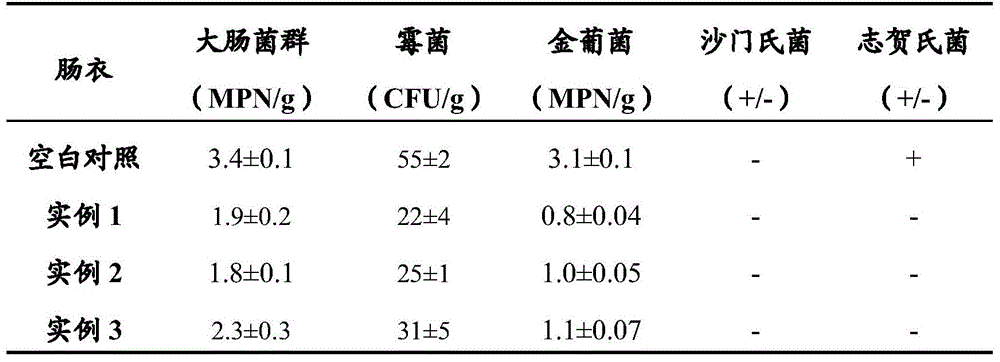A method for efficiently removing gastroenteric content and casing
A technology of intestinal contents and contents, applied in a method and the field of obtained casings, can solve the problems of increasing heparin production cost, poor casing cleanliness, and lower quality, so as to improve the quality of casings, reduce preparation costs, and improve clearance rate effect
- Summary
- Abstract
- Description
- Claims
- Application Information
AI Technical Summary
Problems solved by technology
Method used
Image
Examples
Embodiment 1
[0025] In this example, a method for efficiently removing the contents of the original intestine is provided, and its focus is on the configuration of tea water. Add 60 g of green tea leaves to each liter of clear water, boil for 10 minutes, filter out the dregs, and then dilute to the original volume with clear water. 4 times to get the desired tea water.
[0026] A described method for efficiently removing gastroenteric contents, the steps of which are:
[0027] (1) Preliminary removal of contents: Remove the contents with mechanical equipment, and strictly control the gap between the rollers to 1-5mm.
[0028] (2) Configuration of tea water: Add 60g green tea leaves to 1L of clear water, boil for 5 minutes, filter out the dregs with a filter cloth, dilute to 2L with clear water, and obtain green tea water, wherein the content of tannic acid is 0.5%, and the content of caffeine is 0.075%.
[0029] (3) Lavage and soak: the green tea water prepared in step (2) is continuousl...
Embodiment 2
[0039] (1) Preliminary removal of contents: same as Example 1.
[0040](2) The configuration of tea water: add 60g of green tea leaves to 1L of clear water, boil for 7.5min, filter out the dregs with a filter cloth, dilute to 1.8L with clean water, and then get green tea leaves, in which the content of tannic acid is 0.5%, caffeine The content is 0.08%.
[0041] (3) Lavage and soak: pour the green tea water prepared in step (2) continuously into the original intestine for rinsing, pour one end of the original intestine into the tea water, drive the water to the middle, and then drain the intestine Pull it into a button, soak it in tea water for 3 hours, and rinse it with clean water.
[0042] The residual content in the intestinal mucosa obtained by scraping the intestines is 1%, and the content of vitamin C in the casing is 0.002%, and the content of tea polyphenols is 0.04%.
Embodiment 3
[0044] (1) Preliminary removal of contents: same as Example 1.
[0045] (2) Preparation of tea water: Add 60g of white tea per 1L of water, boil for 10 minutes, filter out the dregs with a filter cloth, dilute to 3L with water, and obtain white tea water, in which the content of tannic acid is 0.3%, and the content of caffeine is 0.06 %.
[0046] (3) Lavage and soak: pour the white tea water prepared in step (2) continuously into the original intestine for rinsing, pour one end of the original intestine into the tea water, drive the water to the middle, and then drain the intestine Pull it into a button, soak it in tea water for 3 hours, and rinse it with clean water.
[0047] The residual content in the intestinal mucosa obtained by scraping the intestines was 3.5%, and the content of vitamin C in the casing was 0.001%, and the content of tea polyphenols was 0.03%.
PUM
 Login to View More
Login to View More Abstract
Description
Claims
Application Information
 Login to View More
Login to View More - R&D
- Intellectual Property
- Life Sciences
- Materials
- Tech Scout
- Unparalleled Data Quality
- Higher Quality Content
- 60% Fewer Hallucinations
Browse by: Latest US Patents, China's latest patents, Technical Efficacy Thesaurus, Application Domain, Technology Topic, Popular Technical Reports.
© 2025 PatSnap. All rights reserved.Legal|Privacy policy|Modern Slavery Act Transparency Statement|Sitemap|About US| Contact US: help@patsnap.com



